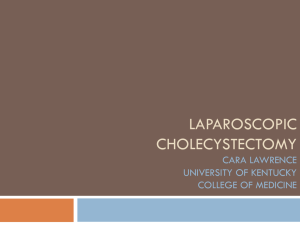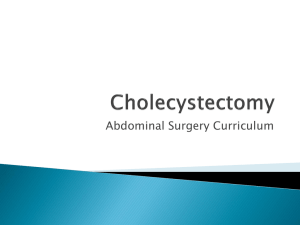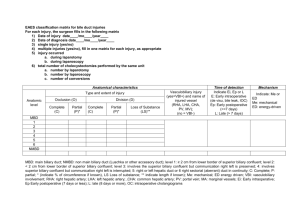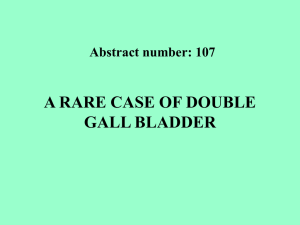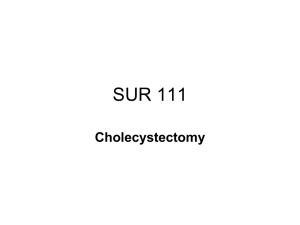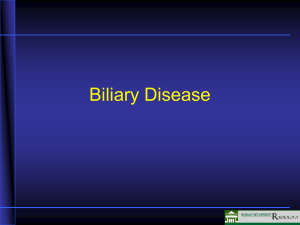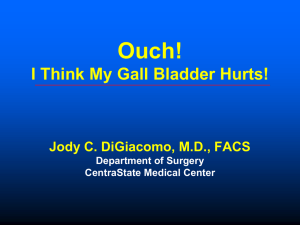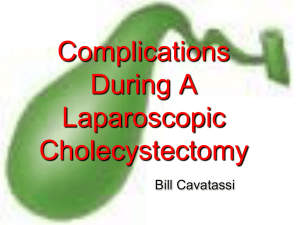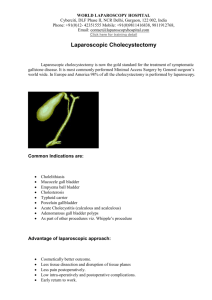Chapter9 - World Laparoscopy Hospital
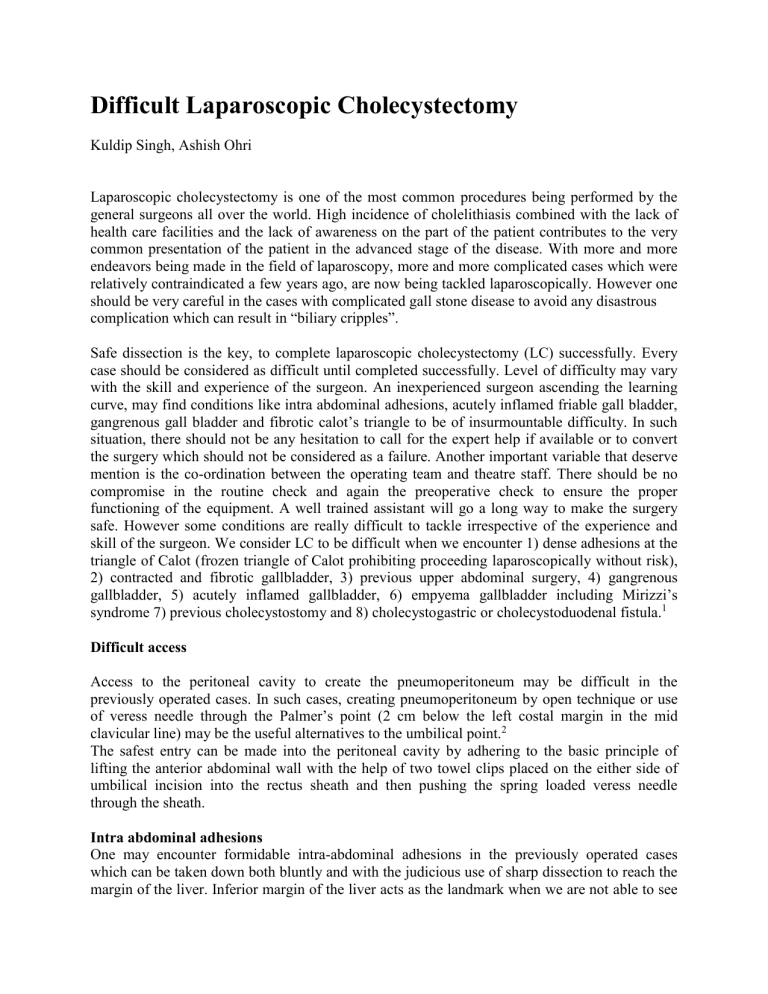
Difficult Laparoscopic Cholecystectomy
Kuldip Singh, Ashish Ohri
Laparoscopic cholecystectomy is one of the most common procedures being performed by the general surgeons all over the world. High incidence of cholelithiasis combined with the lack of health care facilities and the lack of awareness on the part of the patient contributes to the very common presentation of the patient in the advanced stage of the disease. With more and more endeavors being made in the field of laparoscopy, more and more complicated cases which were relatively contraindicated a few years ago, are now being tackled laparoscopically. However one should be very careful in the cases with complicated gall stone disease to avoid any disastrous complication which can result in “biliary cripples”.
Safe dissection is the key, to complete laparoscopic cholecystectomy (LC) successfully. Every case should be considered as difficult until completed successfully. Level of difficulty may vary with the skill and experience of the surgeon. An inexperienced surgeon ascending the learning curve, may find conditions like intra abdominal adhesions, acutely inflamed friable gall bladder, gangrenous gall bladder and fibrotic calot’s triangle to be of insurmountable difficulty. In such situation, there should not be any hesitation to call for the expert help if available or to convert the surgery which should not be considered as a failure. Another important variable that deserve mention is the co-ordination between the operating team and theatre staff. There should be no compromise in the routine check and again the preoperative check to ensure the proper functioning of the equipment. A well trained assistant will go a long way to make the surgery safe. However some conditions are really difficult to tackle irrespective of the experience and skill of the surgeon. We consider LC to be difficult when we encounter 1) dense adhesions at the triangle of Calot (frozen triangle of Calot prohibiting proceeding laparoscopically without risk),
2) contracted and fibrotic gallbladder, 3) previous upper abdominal surgery, 4) gangrenous gallbladder, 5) acutely inflamed gallbladder, 6) empyema gallbladder including Mirizzi’s syndrome 7) previous cholecystostomy and 8) cholecystogastric or cholecystoduodenal fistula.
1
Difficult access
Access to the peritoneal cavity to create the pneumoperitoneum may be difficult in the previously operated cases. In such cases, creating pneumoperitoneum by open technique or use of veress needle through the Palmer’s point (2 cm below the left costal margin in the mid clavicular line) may be the useful alternatives to the umbilical point.
2
The safest entry can be made into the peritoneal cavity by adhering to the basic principle of lifting the anterior abdominal wall with the help of two towel clips placed on the either side of umbilical incision into the rectus sheath and then pushing the spring loaded veress needle through the sheath.
Intra abdominal adhesions
One may encounter formidable intra-abdominal adhesions in the previously operated cases which can be taken down both bluntly and with the judicious use of sharp dissection to reach the margin of the liver. Inferior margin of the liver acts as the landmark when we are not able to see
the gall bladder under the dense adhesions. Dissection close to the liver margin exposes the fundus of the gall bladder which is elevated to give the counter traction to dissect the adhesions till the neck of the gall bladder.
Difficult intra operative pathology
The dissection should be done keeping in mind the anatomy of the hepatobiliary system and proceed step by step till the removal of gallbladder:
1.
Landmark to approach gall bladder – Our routine policy has been to stay close to the liver margin, either medially or laterally to start with, to look for gall bladder under the adhesions.
3
2.
Lift the Hartmann’s pouch from the cystic duct to ensure the safe circumfrential dissection around the cystic duct. Hartmann’s pouch is the normal redundant part of the infundibulum of the gallbladder which lies folded over the cystic duct and becomes adherent to the duct in cases of inflammation of gallbladder. Lifting the pouch early in the dissection allows easier definition of the gall bladder cystic duct junction and circumfrential dissection around the cystic duct.
3.
Define gall bladder neck – to have visualization and proper exposure of cystic artery at the level of gall bladder neck.
3
4.
Define gall bladder/cystic duct junction–surgical dissection of cystic duct and cystic artery should begin adjacent to or near the point of origin of cystic duct or near point of entry of the vessel.
3
5.
Identification of cystic lymph node as a landmark to define cystic duct and cystic artery.
3
6.
Calot’s triangle-Dissection in calot’s triangle should be commenced at a later stage only after identifying gall bladder/ cystic duct junction.
3
the point to keep in mind while dissecting the calot’s triangle is that the tip of the curved dissector should be facing anterolaterally towards the gallbladder to avoid the injury to the liver or the CBD.
7.
Rouviere’s sulcus - It is a 2-5 cm sulcus running to the right of liver hilum anterior to caudate process and usually containing right portal triad or its branches. The sulcus indicates the plane of CBD accurately.
4
8.
Proper localization of common bile duct should be done from time to time during surgery by retracting the duodenum downwards, keeping in mind the plane of rouviere’s sulcus and retracting the right lobe of liver with proper traction to the Hartmann’s pouch.
9.
Maintain the plane of dissection in the cholecystic plate while removing the gallbladder from the liver. Dissection deeper to this plane will cause injury to the liver and may cause troublesome bleeding while dissection superficial to this plane may cause perforation of the gallbladder and spillage of bile. Moreover dissection in the plane superficial to the cholecystic plate in the subserosa of gallbladder will violate the oncologic plane if the biopsy of the gallbladder shows an incidental Stage 1 carcinoma and the redo surgery in the form of extended cholecystectomy is mandatory in such situation.
Useful aids to dissection which needs mention include placement of additional trocar, frequent irrigation and suction, use of suction canula for dissection, use of gauze piece in case of minor bleed and adequate traction on the infundibulum of gall bladder to display structures in the calot’s triangle. Every effort should be made to avoid the spillage of bile into the peritoneal cavity as this will increase the incidence of postoperative infection, abscess formation and also make the incidental stage 1 carcinoma into Stage 4.
In the recent literature use of harmonic scissors has been reported to be safer than electrocautery but it is still not a viable option in a cost constrained country. Reportedly better outcome has been reported with the use of fundus first technique in a recent study but it requires more evidence to be used as an alternative.
5
Intra-operative cholangiogram (IOC)
Laparoscopic cholecystectomy can be performed safely without routine IOC.
6
Although there has been stress on the routine use of IOC in LC in the past to delineate the extrahepatic biliary anatomy and to know the status of the CBD,
7
selective use of IOC has been recommended in recent studies when the learning curve for the LC is over.
8
Wider availability and efficient application of the ultrasonographic imaging and ERCP may be the reason to recommend selective rather than routine use of IOC.
6, 9 Emphasis should be on detecting choledocholithiasis pre-operatively and subject the patient to LC after CBD clearance. For the purpose of teaching one may consider the need for the selective use of IOC to make the young surgeons oriented to the technique and interpretation of the procedure. A new technique has been described by injecting the methylene blue into the lumen of gall bladder to delineate the cystic duct and CBD.
This technique seems easier to perform, without any radiation exposure and less time consuming than conventional IOC.
10
Conversion to open surgery
Conversion to the open procedure should not be taken as a failure or a complication on the part of the surgeon. More and more difficult cases being taken up for LC which will increase the incidence of conversions also. Series vary widely in the conversion rates depending upon the number of patients and the experience of the surgeon. Common reasons for conversion are listed in Table 1.
When to convert
Table 1
Unclear anatomy
Failure to progress in dissection
Injury to major blood vessel
Injury to abdominal viscus
Injury to bile duct
Choledocholithiasis untreatable by laparoscopic technique as per the facilities and expertise available
A recent report emphasizes the fact that the outcome of the patient is not influenced by the rank of the surgeon performing the surgery.11 However, the consensus has been that every surgeon has to undergo a learning curve for the laparoscopic procedure and develop his dexterity in laparoscopy. Endoscopic simulators and endotrainers are of great help for the young surgeons.
Bile duct injuries
Bile duct injury is the most catastrophic event that can happen to a patient undergoing LC, leaving the patient with high morbidity and high treatment cost. Surgical literature is full of the series and meta analyses emphasizing the fact that incidence of bile duct injuries have risen after the advent of LC. The learning curve contribution to bile duct injuries is now much less important as the surgical residents learn the procedure under direct supervision of more experienced surgeons. Data are insufficient to determine precisely the frequency of bile duct injuries, but one of the latest large studies from Italy reports the incidence of bile duct injuries as
0.42% which is still more than open cholecystectomy.
Strategies to avoid bile duct injuries 12
Adherence to the basic protocol of surgery and progressing step by step while following the landmarks of hepatobiliary anatomy as discussed earlier.
Convert when in doubt.
Do not clip any structure till anatomy is clear.
Use of virtual reality simulation for the training of young surgeons.
Application of the objective system like (OCHRA) Observational Clinical Human
Reliability Assessment system to identify and categorize the technical errors during LC.
Avoid the instinct to remove the gall bladder completely and accept subtotal cholecystectomy as a reasonable alternative to LC when desirable.
Use high quality imaging equipment.
Minimal use of electro cautery in calot’s triangle.
Preferable use of a 300 telescope to have a better viewof calot’s triangle.
Various systems have been described to classify the bile duct injuries and plan for effective management. The most commonly used classifications are Strassberg classification, Bismuth classification and Stewart Way classification systems. The most important and the classic mechanism of laparoscopic bile duct injury was described by Davidoff et al. Here excessive traction on the infundibulum causes the CBD to align with the cystic duct and the CBD is cut instead of the cystic duct. Further dissection goes on lifting the CBD and again the common hepatic duct is divided near the hilum.
When to think “Are you dissecting the CBD instead of cystic duct”
The duct when clipped is not fully encompassed by a standard 9 mm clip.
Any duct that can be traced without interruption to course behind the duodenum is probably CBD.
The presence of another unexpected ductal structure after cutting the first one.
Large artery behind the duct.
Extra lymphatic and vascular structures encountered in the dissection.
Management of bile duct injuries remains an area of high expertise. If the injury is detected intra operatively and necessary facilities with expertise are available, the repair should be done in the same operation. If facilities or expertise is not available, drain the peritoneal cavity and refer the patient to higher centre. However if the injury is detected post operatively, get the ERCP to
localize the leak and if possible, stent the system for decompression. If the system is completely blocked, wait for the intrahepatic and hilar ducts to dilate and do the interval repair. The most important fact to be kept in mind is that the best chance for the patient’s long term recovery is at the first repair, so never try to give it a chance if expertise is not available.
Salient points
Every case should be considered as difficult until completed successfully. Level of difficulty may vary with the skill and experience of the surgeon.
Some conditions are really difficult to tackle irrespective of the experience and skill of the surgeon like dense adhesions at the triangle of Calot, contracted and fibrotic gallbladder, previous upper abdominal surgery, gangrenous gallbladder, acutely inflamed gallbladder, empyema gallbladder including Mirizzi’s syndrome, previous cholecystostomy and cholecystogastric or cholecystoduodenal fistula.
Creating pneumoperitoneum by open technique or use of veress needle through the
Palmer’s point could be the useful alternatives to the umbilical point.
The dissection should be done keeping in mind the anatomy of the hepatobiliary system and proceed step by step till the removal of the gallbladder.
Conversion to the open procedure should not be taken as a failure or a complication on the part of the surgeon.
If CBD injury occurs, the best chance for the patient’s long term recovery is at the first repair.
References
Singh K, Ohri A. Difficult laparoscopic cholecystectomy: a large series from north India.
Ind J Surg 2006; 68(4):205-208.
Gunenec MZ, Yesildaglar N, Bingol B, Onalan G, Tabak S, Gokmen B. The safety and efficacy of direct trocar insertion with elevation of the rectus sheath instead of the skin for pneumoperitoneum. Surg Laparosc Endosc Percutan Tech. 2005 Apr;15(2):80-81.
Singh K, Ohri A. Anatomic landmarks: their usefulness in safe laparoscopic cholecystectomy.Surg Endosc. 2006 Nov;20(11):1754-8. Epub 2006 Sep 23.
Rouviere H. Sur la configuration et la signification du sillon du cprocessus caude.
Bulletins et memoires de la societe anatomique de paris. 1924; 94: 355-358.
Cengiz Y, Janes A, Grehn A, Israelsson LA. Randomized clinical trial of dissection with electrocautery versus ultrasonic fundus first dissection in laparoscopic cholecystectomy.
Br J Surg 2005; 92: 810-813.
Gilliams A, Cheslyn-Curtis S, Russell RC, Lees WR. Can cholangiography be safely abandoned in laparoscopic cholecystectomy? Ann R Coll Surg Engl 1992; 74: 248–251.
Cuschieri A, Shimi S, Banting S, Nathanson LK, Pietrabissa A. Intraoperative cholangiography during laparoscopic cholecystectomy: routine vs selective policy. Surg
Endosc 1994; 8:302–305.
Misra M, Schiff J, Rendon G, Rothschild J, Schwaitzberg S. Laparoscopic cholecystectomy after the learning curve: what should we expect? Surg Endosc 2005;19:
1266–1271.
Barwood NT, Valinsky LJ, Hobbs MS, Fletcher DR, Knuiman NW, Ridout SC.
Changing methods of imaging the common bile duct in laparoscopic cholecystectomy era in western Australia:implications for surgical practice. Ann Surg 2002; 235:41–50.
Sari YS, Tunali V, Tomaoglu K, Karagoz B, Guneyi A, Karagoz I. Can bile duct injuries be prevented? “A new technique in laparoscopic cholecystectomy”. BMC Surg. 2005 Jun
17;5:14.
Knight JS, Mercer SJ, Somers SS, Walters AM, Sadek SA, Toh SK. Timing of urgent laparoscopic cholecystectomy does not influence conversion rate. Br J Surg 2004;91:601-
4.
Way LW, Stewart L, Gantert W, Liu K, Lee CM, Whang K, Hunter JG. Causes and prevention of laparoscopic bile duct injuries: analysis of 252 cases from a human factors and cognitive psychology perspective.Ann Surg. 2003 Apr;237(4):460-469.
